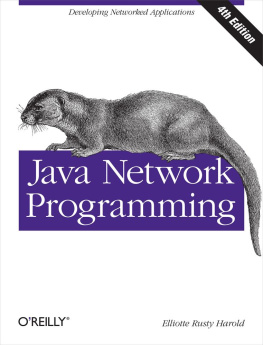1. Architecture
This chapter covers the major architectural features of distributed systems. You cant build a system without some idea of what you want to build. And you cant build it if you don't know the environment in which it will work. GUI programs are different than batch processing programs; games programs are different than business programs; and distributed programs are different than standalone programs. They each have their approaches, their common patterns, the problems that typically arise, and the solutions that are often used.
This chapter covers the high-level architectural aspects of distributed systems. There are many ways of looking at such systems, and many of these are dealt with.
Protocol Layers
Distributed systems are hard . There are multiple computers involved, which have to be connected in some way. Programs have to be written to run on each computer in the system and they all have to cooperate to get a distributed task done.
The common way to deal with complexity is to break it down into smaller and simpler parts. These parts have their own structure, but they also have defined means of communicating with other related parts. In distributed systems, the parts are called protocol layers and they have clearly defined functions. They form a stack, with each layer communicating with the layer above and the layer below. The communication between layers is defined by protocols.
Network communications requires protocols to cover high-level application communication all the way down to wire communication and the complexity handled by encapsulation in protocol layers.
ISO OSI Protocol
Although it was never properly implemented, the OSI (Open Systems Interconnect ) protocol has been a major influence in ways of talking about and influencing distributed systems design. It is commonly given as shown in Figure .
Figure 1-1.
The Open Systems Interconnect protocol
OSI Layers
The function of each layer from bottom to top is as follows:
The Physical layer conveys the bit stream using electrical, optical, or radio technologies.
The Data link layer puts the information packets into network frames for transmission across the physical layer, and back into information packets.
The Network layer provides switching and routing technologies.
The Transport layer provides transparent transfer of data between end systems and is responsible for end-to-end error recovery and flow control.
The Session layer establishes, manages, and terminates connections between applications.
The Presentation layer provides independence from differences in data representation (e.g., encryption).
The Application layer supports application and end-user processes.
TCP/IP Protocol
While the OSI model was being argued, debated, partly implemented, and fought over, the DARPA Internet research project was busy building the TCP/IP protocols . These have been immensely successful and have led to The Internet (with capitals). This is a much simpler stack, as shown in Figure .
Figure 1-2.
The TCP/IP protocols
Some Alternative Protocols
Although it almost seems like it, the TCP/IP protocols are not the only ones in existence and in the long run may not even be the most successful. Wikipedias list of network protocols (see https://en.wikipedia.org/wiki/List_of_network_protocols_(OSI_model) has a huge number more, at each of the ISO layers. Many of these are obsolete or of little use, but due to advances in technology in all sorts of areassuch as the Internet in Space and the Internet of Thingsthere will always be room for new protocols.
The focus in this book is on the TCP/IP (including UDP) layer, but you should be aware that there are other ones.
Networking
A network is a communications system for connecting end systems called hosts. The mechanisms of connection might be copper wire, Ethernet, fiber optic, or wireless, but that wont concern us here. A local area network (LAN) connects computers that are close together, typically belonging to a home, small organization, or part of a larger organization.
A Wide Area Network (WAN) connects computers across a larger physical area, such as between cities. There are other types as well, such as MANs (Metropolitan Area Network ), PANs (Personal Area Networks), and even BANs (Body Area Network ).
An internet is a connection of two or more distinct networks, typically LANs or WANs. An intranet is an internet with all networks belonging to a single organization.
There are significant differences between an internet and an intranet. Typically, an intranet will be under a single administrative control, which will impose a single set of coherent policies. An internet, on the other hand, will not be under the control of a single body, and the controls exercised over different parts may not even be compatible.
A trivial example of such differences is that an intranet will often be restricted to computers by a small number of vendors running a standardized version of a particular operating system. On the other hand, an internet will often have a smorgasbord of different computers and operating systems.
The techniques of this book are applicable to internets. They are also valid with intranets, but there you will also find specialized, non-portable systems.
And then there is the mother of all internets: The Internet. This is just a very, very large internet that connects us to Google, my computer to your computer, and so on.
Gateways
A gateway is a generic term for an entity used to connect two or more networks. A repeater operates at the physical level and copies information from one subnet to another. A bridge operates at the data link layer level and copies frames between networks. A router operates at the network level and not only moves information between networks but also decides on the route.
Packet Encapsulation
The communication between layers in either the OSI or the TCP/IP stacks is done by sending packets of data from one layer to the next, and then eventually across the network. Each layer has administrative information that it has to keep about its own layer. It does this by adding header information to the packet it receives from the layer above, as the packet passes down. On the receiving side, these headers are removed as the packet moves up.
For example, the TFTP (Trivial File Transfer Protocol ) moves files from one computer to another. It uses the UDP protocol on top of the IP protocol, which may be sent over Ethernet. This looks like the diagram shown in Figure .
Figure 1-3.
The TFTP (Trivial File Transfer Protocol)














